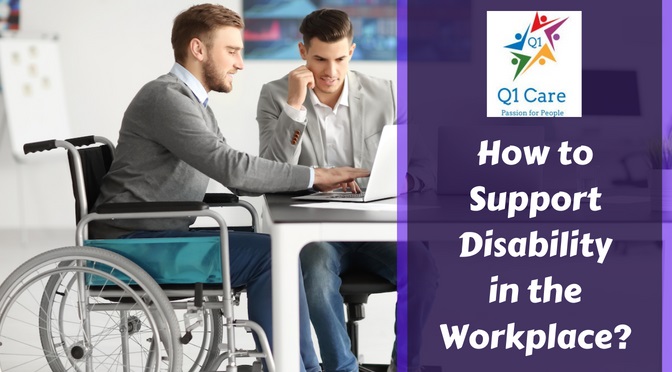Over 1 billion people around the globe live with some form of disability!
Imagination Time: Let’s Assume!
Imagine you are blind. Now with that disability, imagine getting ready for work in the morning, you must do your personal grooming, like shaving or putting on your makeup. You have to pick out your clothes and make sure they match. You must prepare your breakfast and get your lunch packed and get ready for your day. Now, go ahead and open your eyes. Thanks for playing along. Now, when you are imagining yourself with this disability, did you think in terms of visual impairment, were you blind? Did you have a hearing impairment? Were you deaf? Did you have a mobility impairment? Were you in a wheelchair or had difficulty moving? Maybe you went in a different direction, and you had a speech impairment or trouble breathing trouble focusing. You probably had difficulty with those daily activities.
Definitions of Disability
When you envisioned yourself with a disability, it’s okay to admit it. Your daily life would be impacted if you had a disability. Now there are as many definitions of the word disability as there are impairments that cause it, but what all of the definitions have in common is the word inability. You probably had a difficult time in your imagination, getting ready for work with the disability because we think in terms of disability, by what someone can or can’t do a blind person, can’t see a deaf person. Can’t hear someone in a wheelchair. Can’t walk. We are programmed to think about all of the things, someone with a disability can’t do. That’s a really dangerous train of thought. You and I wouldn’t want someone making all of these misconceptions about us and judging us based solely on what’s happened to us.
Pity is Not Fun

We wouldn’t want a conversation to start from a place of pity. That’s not fun. That’s not fun for you. That’s not fun for me. And what’s dangerous about it is when we get to the workplace, your misconceptions shouldn’t affect my ability to get a job, or be successful in that job. And while being treated like a human. But unfortunately, people with disabilities face an unemployment rate that is historically double that of people without a disability. Now I’m sure we’ve all been in a situation where we’ve been out, looking for work, filling out applications, doing our cold calls, and going on those awkward interviews. We’ve all had that experience and it can be discouraging. Imagine facing the statistic that it’s likely not going to work out well for you. How long before you just give up? Unfortunately, that’s what happens. People with disabilities are far more likely to opt-out of the workforce altogether.
Rethink Disability
The above experience is so sad because people with disabilities have so much to offer, but we can change that right here. Right now, all of us can change so that we can rethink disabilities in the workplace. And it’s three simple steps. I promise. They’re really simple. How we start is we seek to understand that’s step number one, let’s understand what it means to have a disability. Not all disabilities are visible, and you can’t just focus on what someone can or can’t do. Consider someone with an executive processing disorder, commonly known as attention deficit hyperactivity disorder. And if you just think about those deficits or those challenges, you might miss out on other things they do have to offer in an employment setting in the workplace, which brings us to step number two of how we can rethink disabilities in the workplace.

Instead of just stopping at thinking about what people can’t do, because they have a disability, let’s think about what someone has to offer. Let’s think about what people what things people can do despite their disability or because of their disability. We know that there are benefits to having a disability because you learn to overcome it. Now individuals with disabilities just need a chance. So in your workplace, in your employment setting, whatever that looks like, how can you be more inclusive for people with disabilities? Does that mean you’re more friendly to customers who have a disability? Does that mean you make sure that the website of your company is more blind-friendly? Do you have training for your employees to make sure that they can interact with people with disabilities? A little bit more sensitively? There are so many things that we can do to make sure that our workplaces are more inclusive. You know, disabilities advocates like Q1 Care, we like to say that the disabled population is the one minority group that anyone of us could join at any time. If there were ever a time to start treating people the way you want to be treated, this is it. Let’s rethink disabilities in the workplace.
Rethink Business Strategy
Not all businesses are equipped to support persons with disabilities, which in many instances impedes their ability to thrive within existing environments. The state of our mental and physical health is fundamentally linked. Understanding the links between mind and body will help a company develop strategies to create conversations surrounding support, identifying a need, and building engagement, creating an inclusive workplace means increasing your talent pool, attracting high-skill candidates, enhancing your team’s performance, boosting productivity and becoming an employer of choice. Ensure application forms and job descriptions are genuinely accessible. Focus. The job description on essential criteria rather than preferred attributes and characteristics think about any participation needs. People with disabilities might have at the workplace, such as wheelchair accessibility, hearing loops or computer access modify your working arrangements. Consider providing natural light noise, canceling headphones, and quiet spaces.

Assistive technologies such as screen readers, transcription software modified phones, and hearing loop systems can help with hearing and site disabilities. It is vital to ensure you are actively recruiting and supporting employees and their needs, employees, and managers without disabilities may be unaware of the needs and support required for colleagues who may have a disability beyond adjusting your workplace to accommodate the various types of disabilities that exist. Think about ways for workers with disabilities to thrive at the office. The aim is to treat all employees fairly and pay employees with disabilities equally. As a result, the company’s reputation as a diverse and inclusive employer should help to attract talent and create a more collaborative and engaged workforce. This issue isn’t just about making certain offices accessible. It’s about knowing what’s important and designing experiences that are needed and wanted as a result. It enables those with disabilities to thrive.
Thank you.





